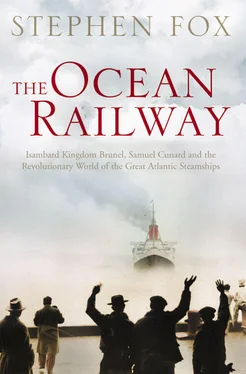A more balanced report on the first Cunard steamships required testimony from someone who had already crossed the North Atlantic by sailing ship and so could compare the passages. Fanny Appleton of Boston took the Columbia to Liverpool in May 1841, five and a half years after her tedious voyage to Le Havre by sailing packet (see pages 8-9). ‘Tho’ I miss of course the beautiful shiftings and exhilaration of a sailing vessel,’ she noted soon after the Columbia left Boston, ‘yet we bound over the waves with no little dignity and grace.’ Constant shipboard noises on the packet had kept her from reading and writing; her first surprise on the Cunard ship was the prevailing near-silences compared to what she had found on various sailing ships and American steamboats. ‘One thing excites my unbounded admiration – the marvellous quiet. There is none of the constant bawling of orders (the Capt’s are given sotto voce to a certain little “Mr. Finley” who, like a familiar, is ever at his elbow) nor racket of ropes, nor rushing about of sailors, nor even some creaking of masts as in a packet; neither the monotonous plunge of the engine as in our steamers. There is a slight trembling of course but not a sound from the machinery… The only sounds are the bells every hour, the bugle to summon us to meals, the slight sighing of the valves.’ Napier’s machinery was barely audible – and invisible as well, unlike the engines on American steamers, concealed below decks and propelling the ship into an ‘easy majestic motion’.
Eight days later, five days from Liverpool, Appleton was still surprised and pleased. ‘This steaming is all play-sailing compared to packet experience,’ she decided, ‘and the big Atlantic itself seems vastly shrunken and dwarfed to me now that we are rushing across it so comfortably, so independant of its head winds, so little wrenched from our equilibrium by its uneasy tossings and tumblings. I little thought I could prefer a steamer but so it is. We have no excuse for grumbling at anything.’ The passengers behaved well, not too numerous or drunk or talkative. Captain Charles H. E. Judkins, meticulously attentive to every detail, took a southerly course to avoid icebergs. (They still passed a group of ten icebergs about a mile away; the largest – eighty feet high and a quartermile long, greenish in the crevices and snowy at the top – resembled a ghostly steamship at that distance.) The Columbia’s food was bountiful and varied; the shipboard games, dances and concerts were all diverting. ‘Instead of finding a steam-ship a floating Pandemonium as I expected, it certainly puts packets to shame for comfort and luxury and slides me over the Atlantic’ Appleton was not even bored; ‘I feel almost sorry to quit the ship we are having such amusing times.’ They reached Liverpool in just half the duration of her packet voyage to Le Havre in 1835.
Appleton’s account carried its own bias. Instead of westbound in January, like Dickens, she was eastbound in May, through gentle weather. Her father and uncle, Nathan and William Appleton, were business associates of Sam Cunard’s in Boston, and when she went ashore in Halifax she was lavishly entertained by the Cunard family. Still, her description seems more believable than Dickens’s because their motives for writing were so different. He, a famous fiction writer, wanted to spin a good yarn for publication and to sell books, with the more dramatically harrowing details the better. She wrote her version in private, unpublished letters to her father and to her best friend, with no evident purpose except to report honestly on what she had found. (In general, the more confidential the historical source, the more truthful.) Both had brought unmet expectations to the voyage; he was then disappointed and terrified, she unexpectedly pleased. Revising themselves in opposite directions, they gave their accounts quite different tones. Where they disagreed on specific matters of fact – such as the engine’s constant noise level – Appleton had no reason to exaggerate, and Dickens did. So Fanny Appleton probably got it right.
The steamship Presidentwas the last chance for Junius Smith and Macgregor Laird. Designed by Laird with an almost desperate
audacity, built by Curling and Young in London, and engined by Fawcett and Preston in Liverpool, she marked new transatlantic extremes in size, power and luxury. At 2360 tons she was a third larger than the British Queen and twice the size of the Cunard ships. The first liner with three decks, she afforded passengers an open-air promenade on the spar deck in fine weather and a sheltered turn on the main deck below. An elaborate carved figurehead of George Washington thrust forward from the bow; the projecting stern included other carvings and large plate-glass windows. The engine room, with its ornamented pillars and arches and polished iron and brasswork, reminded visitors of a handsome Gothic chapel: a modernist shrine to steam power. The hull was divided into watertight compartments, like earlier ships designed by Laird, ‘ so that the springingof a leak would be attended with comparatively little danger,’ it was explained, ‘and would be readily overcome.’
The opulent interior furnishings hardly hinted at the Smith line’s ongoing financial straits. The main saloon, some eighty feet long and thirty-four feet wide, was finished in a Tudor Gothic style of delicate colours and grained oak. Its four tables and embossed crimson velvet sofas could accommodate up to one hundred diners at once. A wide corridor with even plusher decorations ran from the saloon to staterooms at the stern. Ten oil paintings, executed on canvas to imitate old tapestries, depicted scenes from the life of Christopher Columbus. The corridor was said to resemble a picture gallery, or the upper storey of a first-class hotel. In flashing these historic references and touches of landed luxury, the President’s living quarters were intended to mask a passenger’s sense of crossing the ocean on the latest, yet-unproven steamship.
The money lavished on decorations might better have been applied to the engine. At 540 horsepower it was the most powerful on the ocean; but only a bit more so than the engine of the much smaller British Queen, which was itself underhorsed compared to the Great Western and the Cunard ships. That left the President a much lower ratio of horsepower to tonnage than any of the competing vessels. Some sceptics doubted the President’s stability, suspecting that the third deck might make her top-heavy and too prone to rolling on the North Atlantic’s mountainous swells. She was also shorter and broader than the British Queen, not a likely design for great speed. An undeniably impressive sight, the President was more notable for her cosmetic features than her basic engineering.
She turned out to be a big, gaudy turkey, and a steady disappointment to her owners. Her first two captains were blamed for slow passages and quickly relieved of duty. The President’s lumbering maiden run in the summer of 1840 took sixteen and a half days in each direction. Her second trip home was worse: fighting a heavy gale from the east, in four days from New York she managed only three hundred miles. At that rate she would run out of coal before reaching Liverpool, so she turned around and limped back to New York. Amply coaled up, and with fair winds, she finally arrived at the Mersey on 28 November, ten days overdue: a cause of great relief and rejoicing, since nobody in England knew that she had earlier been forced back to New York. (‘ What on earthor water,’ Isambard brunel had asked in passing, ‘is the President about.’) Laid up for two months through the worst winter weather, and refitted at Plymouth after just two voyages across the ocean, she took three weeks to reach New York in February, her slowest time yet.
Читать дальше












